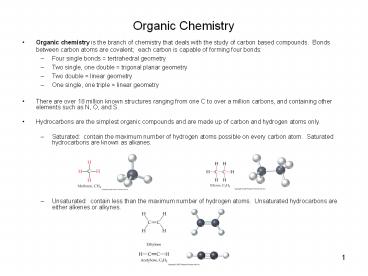Organic Chemistry - PowerPoint PPT Presentation
Title:
Organic Chemistry
Description:
Organic Chemistry Organic chemistry is the branch of chemistry that deals with the study of carbon based compounds. Bonds between carbon atoms are covalent; each ... – PowerPoint PPT presentation
Number of Views:139
Avg rating:3.0/5.0
Title: Organic Chemistry
1
Organic Chemistry
- Organic chemistry is the branch of chemistry that
deals with the study of carbon based compounds.
Bonds between carbon atoms are covalent each
carbon is capable of forming four bonds - Four single bonds tertrahedral geometry
- Two single, one double trigonal planar
geometry - Two double linear geometry
- One single, one triple linear geometry
- There are over 18 million known structures
ranging from one C to over a million carbons, and
containing other elements such as N, O, and S. - Hydrocarbons are the simplest organic compounds
and are made up of carbon and hydrogen atoms
only. - Saturated contain the maximum number of
hydrogen atoms possible on every carbon atom.
Saturated hydrocarbons are known as alkanes. - Unsaturated contain less than the maximum
number of hydrogen atoms. Unsaturated
hydrocarbons are either alkenes or alkynes.
2
Nomenclature of Straight Chained Hydrocarbons
- Composed of a prefix that tells how many carbons
there are. - Meth-
- Eth-
- Prop-
- But-
- Pent-
- Hex-
- Hept-
- Oct-
- Non-
3
Cyclic Hydrocarbons
4
Isomers
- Iso- means same and mers means parts Isomers
are compounds with the same molecular formulas,
but different chemical structures. There are
different types of isomers. - Structural (constitutional)
5
Naming Branched Alkanes, Alkenes and Alkynes
- Branched Alkanes
- Name the longest chain.
- Number that chain so as to give the lowest number
priority to any branched groups. - Name the branched groups.
- Write the full name as one word
- Use hyphens to separate numbers from prefixes
- Use commas to separate numbers from other numbers
- Use alphabetical order to list branched groups
- Branched Alkenes and Alkynes
- 1. Name the longest continuous chain containing
the double or triple bond. - Number the chain giving the lowest priority to
the double or triple bond. - Name and number branched groups.
- 4. Write the full name as one word
- Use hyphens to separate numbers from prefixes
- Use commas to separate numbers from other numbers
- Use alphabetical order to list branched groups
- If it is an alkene, do cis-trans isomers apply?
6
Problems
- Draw the following in structural formulas
- Butane
- Propene
- 2-methyldecane
- Draw the following in line structures
- Trans-3-methyl-3-heptene
- Cyclopentane
- 4-methyl-2-pentyne
- Name
- CH4
- CH3(CH2) 3CH(CH3)2
- Why do we not specify the location of the double
bond in propene? - Why is there no such compound known as methyne?
7
Basic Reactions of Hydrocarbons
- Alkanes Not very reactive. Takes energy from a
spark or heat to get over the activation energy
barrier. - Combustion
- Halogenation
- Alkenes and Alkynes more reactive than alkanes.
- Combustion
- Halogenation
- Hydrogenation
- Hydrohalogenation
- Hydration (alkenes only, alkynes do something
different when hydrated) - Mechanisms A mechanism shows the theoretical
details of a reaction including bond breakage and
formation, and the direction of electron
movement.
8
Problems
- Write out the following reactions using
structural formulas. Show only the MAJOR product
formed. - Methyl propene reacts with HBr
- methylcyclopentene reacts with HCl
- 2-methyl-2-butene reacts with water in the
presence of an acid catalyst - Fill in the product(s) for the reaction shown
below
9
Functional Groups
- When a small portion of a molecule is
responsible for the reactivity of that molecule,
we call that small portion a functional group.
10
IUPAC Nomenclature
- Alcohol Name as usual, -e ending, ol ending
use number to specify alcohol location if there
are 3 or more carbons in the chain - Example ethanol
- NOTE There are two methods of naming alcohols
that are accepted by IUPAC ethyl alcohol is
also acceptable. - Halide Name the halide as a side group using
- Chloro-, Bromo-, Fluoro-, Iodo-
- Example chloromethane
- NOTE There are two methods of naming alkyl
halides that are accepted by IUPAC methyl
chloride is also acceptable. - Ether List alkyl groups alphabetically with the
yl ending and add the word ether - Example diethyl ether
- NOTE There are two methods of naming ethers
that are accepted by IUPAC ethoxyethane is also
acceptable. - Amine Name the alkyl groups alphabetically with
the yl ending and the suffix amine - Example propylamine, N-methylethylamine,
N,N-dimethylproplyamine - NOTE There are two methods of naming amines
that are accepted by IUPAC propanamine is also
acceptable. - Aldehyde Name as usual, -e ending, al ending
- Example methanal and ethanal
11
Problems
- Circle and name each functional group
- 2. Draw structural formulas and line structures
for - 2-pentanol
- Hexanoic acid
- 2-butanone
- Ethyl propyl ether































